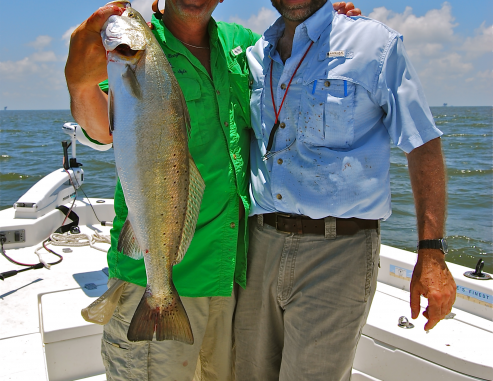
Free-lining live bait key to fooling mature specks, Vidrine says
The way Tommy Vidrine was pounding rocks Monday morning near Grand Isle, you might have thought he was part of an inmate work detail.
The 50-year-old Baton Rouge angler who specializes in tracking down and reeling in big speckled trout started the day at 6 a.m. with a quick stop at the Caminada Pass jetties before heading 8 miles west to the rock breakwaters along Fourchon Beach.
“I like any kind of structure, but that’s really the only structure we have on the front (of the island). We don’t really have any reefs,” Vidrine said. “Those jetty rocks are almost always holding fish, even on a slow day. A lot of baitfish hang out there, so the bigger fish hang out there, too.”
The water was a little dirtier than expected, so it was on to the Belle Pass jetties and eventually out to a rig near Timbalier Island. He stopped for a second look at the Fourchon rocks on the return trip to Caminada Pass, where he found a spot on the eastern jetty and finally located a nice 5.2-pounder.
“Today was less than average on the bite, a lockjaw day,” Vidrine said after the trip. “But even on a lockjaw day, if you work hard and have good bait and know where the trout will be, you can stick and move and stick and move and put together a nice box.”
Vidrine free-lined live shrimp he purchased from Bridge Side Marina, usually with nothing more than a 2/0 circle hook attached to his 15-pound mono line.
“That hook allows the shrimp to move freely, and keeps them alive longer. I target big trout, so if they see a big old hook, they’re a little smarter than the small ones,” he said. “A smaller fish will eat any hook. You can use a 4/0 Kahle hook and throw a shrimp out there under a cork and a small trout will eat it.
“But a 5- or 6-pound trout is a lot wiser. That’s why they’re still there. That’s why they’re that big.”
It’s not especially easy to cast with so little weight, especially in the wind, but Vidrine believes it’s the main reason he can consistently catch big trout.
“In the summer, when there’s that much bait, I try to stick to croakers, pogey and shrimp,” he said. “When that live bait is struggling the most and is vibrant and lively, the big trout can’t stand it. Even if they’re not feeding, they’re going to eat it if it’s jumping around.
“They just can’t resist it. That’s the key – that bait looks like it’s free. It doesn’t look hooked up to anything, but it’s in distress mode, so they’ll strike it.”
Vidrine wasted no time while fishing, effortlessly placing his live bait in and around the rocks wherever he saw hints of cleaner water. As soon as his shrimp drifted out of the strike zone, he reeled in and cast again.
If you’ve never free-lined and are used to fishing with a popping cork or even a Carolina-rigged live shrimp, watching the line, reeling in slack and focusing on the slightest taps of a nibble are crucial.
“Try to find some bigger shrimp, because those little bitty ones are hard to throw,” he said. “It’s a different kind of fishing. It’s not just a cork going down. You feel on that mono line when that fish strikes the bait.”
After two days of relatively rough seas, the water in and around the rocks wasn’t as clean as Vidrine hoped, but he still brought back a box including 12 specks, five redfish, two mangrove snapper and a couple of puppy drum.
“The big swells were still out there, crunching up against the rocks dirtying the water,” he said. “We were away from the rocks where there were smaller trout.”
Even with shrimp in his livewell, Vidrine constantly scanned the horizon looking for signs of his live bait of choice – pogeys. But on this day, they never materialized.
“The key to catching pogeys is finding diving pelicans. We couldn’t get close enough to them on the beach,” Vidrine said, noting he caught about 100 with just two throws of his cast net earlier that weekend. “It’s not supposed to be that hard.
“Pogeys are my favorite bait – period. Any time of year, they are the best bait if you can get them 3- to 4-inches long. If you can get that, you’re going to catch some fish.”
But for the first time in a long time, he saw birds working along the beach at Elmer’s Island.
“That’s a good sign there are more keeper trout in that second trough,” Vidrine said.
For the upcoming 4th of July weekend, Vidrine suggested heading to the breakwater rocks and Fourchon Beach with live croakers Carolina rigged or live shrimp under a popping cork.
“You’re probably going to catch fish,” he said. “Those birds are diving because there are shrimp being chased by trout.”
Back at his camp after the trip, Vidrine pondered why he can’t seem to get enough of Grand Isle life, including fishing, boating and just sitting on his deck and admiring the view.
“The whole experience is refreshing to the soul and the spirit. My friends say I don’t go out there to relax, that I’m at war,” he said with a laugh. “I guess I take it more serious, but I get just as excited as somebody who’s out there for the first time when I catch a 5- or 6-pound fish.
“It doesn’t ever get old for me.”


